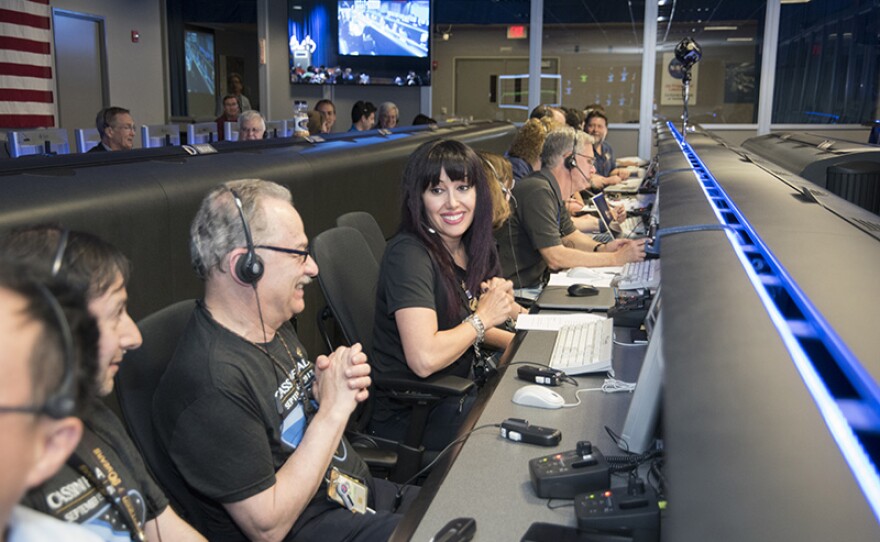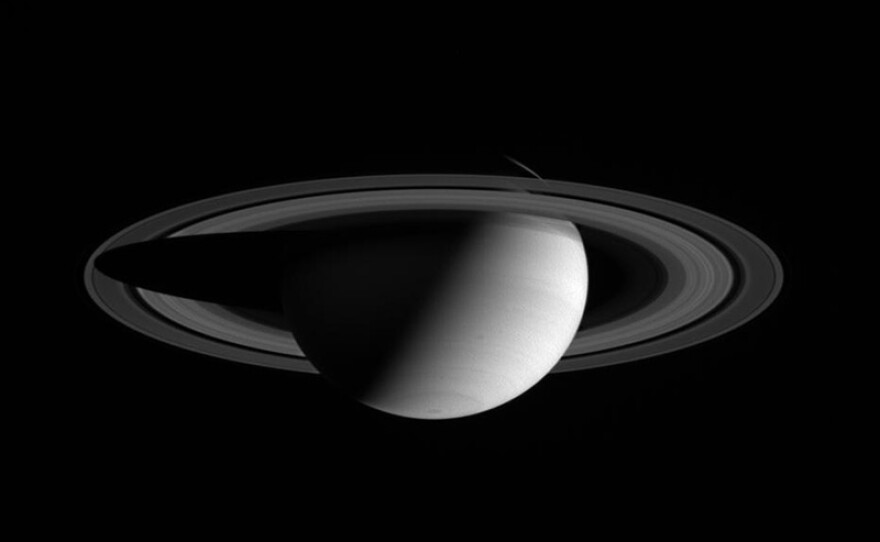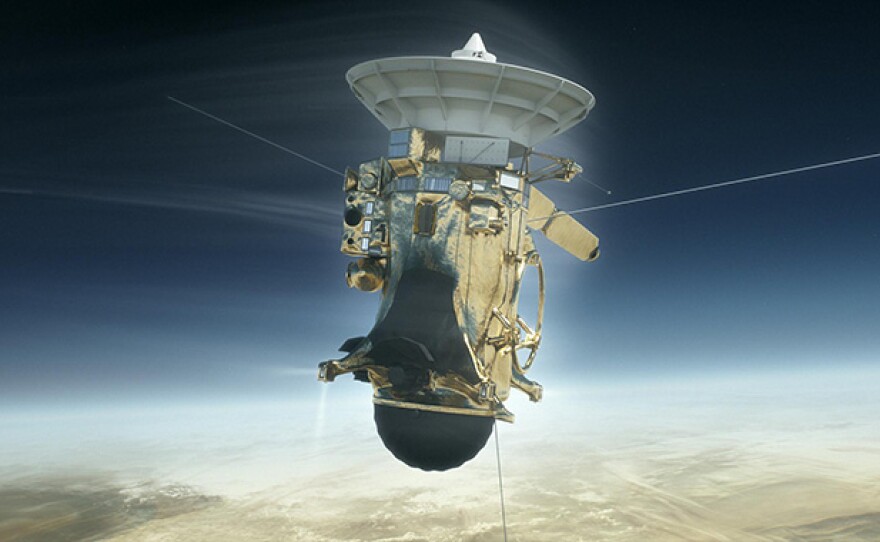Join the space probe Cassini’s final hours as it dives into Saturn’s atmosphere.
This September, after 20 years in space, the Cassini-Huygens mission — one of the most successful missions in the history of space exploration — will come to an end.
Launching in 1997 and arriving at Saturn in 2004, Cassini has sent home miraculous images and scientific data, revealing countless wonders about Saturn, its rings, and dozens of moons — including some that could harbor life.
In its fall season premiere, “Death Dive To Saturn,” NOVA takes viewers on a suspenseful ride inside the mission’s last days, as Cassini attempts one last set of daring maneuvers — a series of dives between Saturn and its innermost ring, before making its final, fateful plunge into the planet’s atmosphere.
NOVA cameras gain unique access to NASA’s Jet Propulsion Laboratory (JPL), the European Space Agency in Holland, the Paris Observatory, and more, to unveil the story behind this extraordinary mission.
S44 Ep12: Death Dive to Saturn Preview
Follow Cassini's final days as it skims the cloud tops before plunging into the planet.
In April 2017, Cassini began a series of 22 dives between the outer edge of Saturn’s atmosphere and the inner edge of its icy rings, closer than any spacecraft has ever ventured.
Just a speck of dust could cripple the spacecraft, traveling 76,000 miles per hour in this unknown region, and slamming into the rocks in the rings is a real possibility.
Each weekly plunge is more dangerous than the one before, and takes researchers deeper towards the atmosphere.

From the first dive through subsequent, increasingly risky dives, NOVA follows Mission Control and NASA engineers as they endure tense and triumphant moments in the hope of discoveries that could solve major mysteries about the planet’s formation, until the probe makes its Grand Finale — plunging into the atmosphere and burning into disintegration.

To complete the story, NOVA producers will be on site at NASA’s JPL in California the entire final week of the mission, including Friday, Sept. 15, 2017, where they will capture Cassini’s final dive, reactions from the mission team, and more. NOVA will share this footage online via social media channels.
Additionally, producers will weave these new moments into the previously broadcast episode, creating an updated version of “Death Dive To Saturn.”
Saturn, its rings, and moons have intrigued stargazers for centuries — including the 17th century astronomers for whom the spacecraft and probe are named.
NOVA travels to Holland to examine an original telescope built by Dutch astronomer Christian Huygens, who discovered Saturn’s rings and its largest moon, Titan, and heads to the Paris Observatory, the site where French astronomer Jean Dominique Cassini discovered six more moons and the division in Saturn’s rings.

To study the gassy giant up close, in depth and at length has required a mission so ambitious, it required the collaboration of dozens of nations — more than 5,000 scientists from nearly 20 countries—pooling their talent and resources to make it possible.
NOVA uses archival footage, cutting edge animation, and firsthand accounts to take viewers behind the scenes and onboard the massive 5,000-pound Cassini spacecraft, with its incredible instruments designed to see, taste, touch, and smell the universe.
Featured experts include NASA Planetary Director Jim Green, Cassini Mission Project Manager Linda Spilker, Cassini Program Manager Earl Maize, Cassini Imaging Team Leader Carolyn Porco, who share key insights on the importance of the mission, the influence of the discoveries and the contributions to astronomy and science.
Team members Michelle Dougherty (Imperial College London), Luciano Iess (Sapienza University Rome) and Richard French (Wellesley College) reveal some of Cassini’s latest discoveries — made during its Grand Finale.

Remarkable discoveries during Cassini’s 20-year mission include:
- Cameras captured the first video of lightning on another planet — 1,000 times stronger than what we have on Earth — in a massive storm encircling Saturn, which can help scientists studying extreme weather and our atmosphere.
- The Huygens probe revealed that Saturn’s moon, Titan, has many Earth-like features, while more than 100 flybys made by Cassini painted a picture of a prebiotic version of Earth, frozen in time, with lakes, mountains and organics. NOVA meets with planetary scientist Alex Hayes, who demonstrates what a lake on Titan might look like compared to one on Earth.
- On Saturn’s moon, Enceladus, the greatest and most unexpected discovery of all was revealed by Cassini flybys: hundreds of plumes spewing icy saltwater and organics into space point to an underground ocean, which may contain hydrothermal vents resembling ones found in Earth’s oceans. Could Enceladus also contain life?
- Saturn has over fifty moons, in all shapes and sizes — from Prometheus, which looks like a potato, and Janus, which resembles a meatball, and Pan, shaped like a ravioli, to Mimas, which bears an uncanny resemblance to the Death Star in Star Wars. But Cassini’s cameras over the years have revealed there may be hundreds of thousands, possibly millions of tiny moons embedded in the rings, called moonlets.
- Cassini Program team member Matt Tiscareno shares a revelation about these moonlets which leaves scientists wondering if the planets in our solar system were formed in a similar fashion.
Tune in to NOVA “Death Dive To Saturn” Wednesday, Sept. 13, 2017 at 9 p.m., and visit pbs.org/nova for updates on the final moments of the Cassini-Huygens mission Friday, Sept. 15, 2017.
“We’re thrilled to give NOVA viewers a front row seat along the dramatic journey and conclusion of one of the most spectacular space explorations of all time,” said Paula S. Apsell, Senior Executive Producer for NOVA. “'In Death Dive To Saturn,' we join world-leading experts in their quest for answers—How old are Saturn’s rings? How were they formed? Why are they so massive?—that could provide us with new and extraordinary insights about how planets form and evolve.”

WATCH ON YOUR SCHEDULE:
Video clips and past episodes of NOVA are available for online viewing for a limited time after each broadcast. Extend your on-demand viewing with KPBS Passport, video streaming for members ($60 yearly) using your computer, smartphone or tablet. We offer Passport videos on ROKU! Activate your benefit now.
JOIN THE CONVERSATION:
NOVA is on Facebook, and you can follow @novapbs on Twitter. #NOVAnext
CREDITS:
A NOVA production for WGBH Boston. Written, produced and directed by Terri Randall. Editor is Jedd Ehrmann. Executive Producer is Julia Cort. Senior Executive Producer for NOVA is Paula S. Apsell.
National corporate funding for NOVA is provided by Draper and 23andMe. Major funding for NOVA is provided by the David H. Koch Fund for Science, the Corporation for Public Broadcasting and public television viewers.





